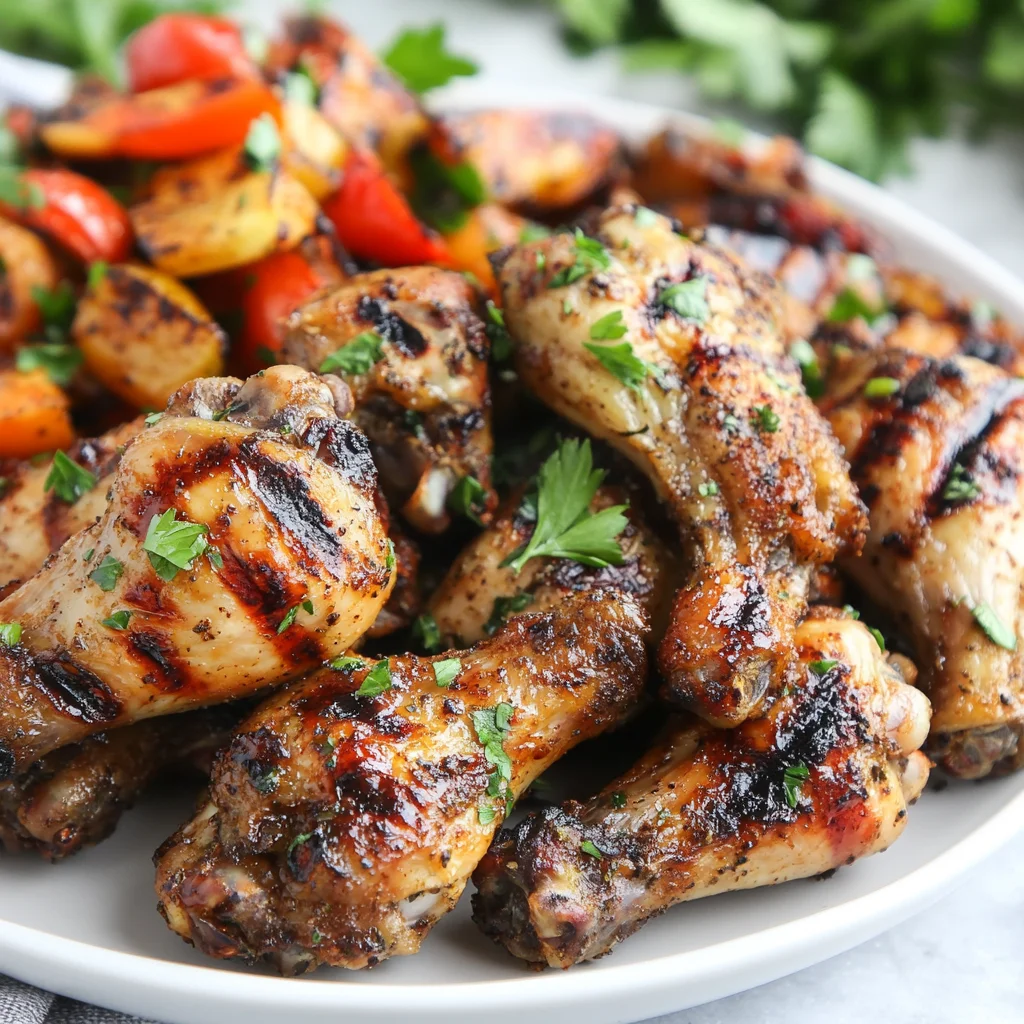There’s nothing quite as satisfying as a perfectly cooked dish, but tackling raw chicken wings can feel intimidating for some. Don’t worry—preparing them is easier than you think! These versatile little gems are not only packed with flavor but are also a fantastic source of protein, making them a healthy addition to any meal. Plus, they’re incredibly fun to experiment with, whether you’re whipping up a spicy game-day snack or crafting a savory family dinner.
The best part? Raw chicken wings are a blank canvas for your creativity—season them, grill them, bake them, or fry them; the options are endless. Imagine the delight of biting into crispy, juicy wings coated with your favorite sauces or spices. It’s comfort food at its finest!
Ready to master this kitchen favorite? Keep reading for tips, tricks, and recipes that will have you cooking like a pro in no time. Trust me, once you try these, you’ll wonder how you ever lived without them!
The Best Ways to Prepare Raw Chicken Wings
Tips for Marinating Raw Chicken Wings

Marinating raw chicken wings is like giving them a little spa day before cooking. It’s simple, fun, and makes a big difference in flavor. First, choose a base like yogurt, soy sauce, or olive oil—this helps the spices stick. Then, add your favorite seasonings, such as garlic, paprika, or lemon juice. The key is to let the wings soak up the goodness for at least an hour, but overnight is even better! This extra time ensures every bite is bursting with flavor. In addition, marinating tenderizes the chicken, making it even juicier when cooked. It’s also super flexible—you can try sweet, spicy, or tangy marinades based on your mood. Remember, raw chicken wings are your canvas, so have fun experimenting! Next time you’re prepping wings, give marinating a try—it’s a game-changer.
For even juicier and more flavorful results, consider trying techniques like brining, which you can learn more about in this guide: Should You Brine a Turkey Breast Before Smoking?.
Cooking Techniques for Juicy Results

Cooking raw chicken wings to perfection isn’t hard; you just need the right techniques. First, decide whether to bake, grill, or fry. Baking is healthier and gives the wings a nice crispy skin. Simply preheat the oven, line a tray with foil, and bake until golden. Grilling, on the other hand, adds a smoky flavor. Just oil the grates, place the wings, and turn them occasionally for even cooking. If you’re craving extra crispiness, frying is your go-to method. Use hot oil and fry until golden brown—super satisfying! Also, remember to check the internal temperature; it should be 165°F to ensure safety. These techniques bring out the best in raw chicken wings, letting their natural flavors shine. So grab your tongs, pick your favorite method, and start cooking! You’re going to love how easy it is.
Why Freshness Matters for Raw Chicken Wings
How to Select High-Quality Chicken Wings
Choosing high-quality raw chicken wings is the first step to a delicious meal. Start by looking at the color—fresh wings should be pinkish, not gray or slimy. Also, check the packaging. It should be sealed tightly with no leaks. In addition, give it a quick sniff; fresh chicken has a mild, neutral smell. Next, consider the source. Buying from a trusted butcher or grocery store ensures better quality. You can also ask for organic or free-range options if you prefer. Finally, pay attention to the expiration date. Always choose wings with the longest shelf life. This ensures they stay fresh until you’re ready to cook. Picking the best wings may seem small, but it makes a big difference in flavor and safety. Plus, it’s easy once you know what to look for!
Storing Raw Chicken Wings for Maximum Freshness
Keeping raw chicken wings fresh is super important for taste and safety. First, store them in the fridge at 40°F or below. If you’re not cooking them within two days, freeze them instead. Next, use airtight bags or containers to prevent air exposure and freezer burn. Label the packaging with the date so you know how long they’ve been stored. Also, separate the wings from other foods to avoid cross-contamination. When thawing, always do it in the fridge, not on the counter—this keeps bacteria at bay. Planning to marinate? You can do that while they’re thawing for extra flavor. Proper storage keeps raw chicken wings fresh and ready for your next culinary adventure. It’s a small step that makes a big difference.
Delicious Recipes Using Raw Chicken Wings
Quick and Easy Appetizer Ideas
Raw chicken wings are perfect for quick and tasty appetizers that impress everyone. Start with classic buffalo wings—just bake or fry the wings, then toss them in a buttery hot sauce. For a sweet twist, try honey garlic wings. Simply coat the wings in a mix of honey, soy sauce, and garlic before cooking. If you love bold flavors, jerk chicken wings are another great option. Marinate them in jerk seasoning and grill to perfection. These recipes are easy to make and great for parties or game nights. In addition, you can serve them with celery sticks or ranch for dipping. Whichever recipe you choose, these appetizers are sure to be a hit. So grab your wings, get creative, and let the fun begin!
Flavorful Sauces to Pair with Chicken Wings
Sauces take raw chicken wings to the next level, and the options are endless. For something classic, you can’t go wrong with barbecue sauce—sweet, smoky, and perfect for dipping. If you like it spicy, sriracha mayo adds a creamy kick. Feeling adventurous? Try a tangy teriyaki glaze or zesty lemon pepper butter. These sauces are simple to whip up and make a big impact on flavor. In addition, you can mix and match sauces for variety—serve two or three at a time for extra fun. A great sauce makes every bite better, turning plain chicken wings into a flavor explosion. So grab your mixing bowl and start experimenting with your favorites. Your taste buds will thank you!
Safe Handling Practices for Raw Chicken Wings
Preventing Cross-Contamination in Your Kitchen
Handling raw chicken wings safely starts with keeping everything clean. First, use a separate cutting board for the wings to avoid spreading germs to other foods. Next, wash your hands with soap and water before and after handling the chicken. Also, clean knives, counters, and other utensils immediately. These steps prevent bacteria from spreading and keep your kitchen safe. In addition, never let raw chicken touch ready-to-eat items like salads or bread. Simple changes in your routine can make a huge difference. By staying mindful of cross-contamination, you’ll enjoy cooking without worry.
Proper Cleaning After Handling Chicken
After handling raw chicken wings, proper cleaning is essential for safety. Start by washing your hands thoroughly with soap and warm water for at least 20 seconds. Next, clean all surfaces and utensils with hot, soapy water. Disinfect cutting boards and countertops with a solution of bleach and water for extra protection. Also, don’t forget to wash dishcloths or sponges used during preparation. Keeping everything clean ensures no harmful bacteria remain in your kitchen. Plus, it only takes a few minutes but makes a big difference in food safety.
The Nutritional Benefits of Raw Chicken Wings

Protein and Essential Nutrients in Chicken Wings
Raw chicken wings are more than tasty—they’re packed with protein and essential nutrients. Protein helps build muscles and keeps you feeling full longer. In addition, chicken wings provide vitamins like B6, which supports brain health, and niacin, which boosts energy levels. They’re also a good source of minerals like phosphorus and selenium. Phosphorus keeps your bones strong, while selenium supports your immune system. Including chicken wings in your diet is a delicious way to stay healthy. Just remember to balance them with other foods for a well-rounded meal.
How Chicken Wings Fit into a Balanced Diet
Chicken wings can be part of a balanced diet when prepared thoughtfully. Start by baking or grilling them instead of frying to reduce calories and fat. Pair them with a side of veggies or a fresh salad for added nutrients. In addition, control portion sizes to avoid overeating. Enjoying wings in moderation ensures you get their benefits without overindulging. They’re versatile, tasty, and can easily fit into a healthy lifestyle. So next time you crave wings, enjoy them guilt-free with these simple adjustments!
Frequently Asked Questions (FAQs)
Can you eat undercooked chicken wings?
No, you shouldn’t eat undercooked chicken wings. Eating them can make you sick because harmful bacteria like salmonella may still be present. Cooking wings thoroughly kills these bacteria and makes them safe to eat. The safest way to know if they’re fully cooked is by using a meat thermometer. The internal temperature should reach 165°F. This ensures they’re cooked all the way through. In addition, undercooked wings may look raw or have a chewy texture. So, it’s always better to cook them a little longer than to risk eating them undercooked. Safety first—then enjoy your wings!
Is it okay if chicken wings are a little pink?
Yes, chicken wings can be slightly pink and still be safe to eat, as long as they’re fully cooked. The key is checking the internal temperature. Use a meat thermometer to ensure the wings reach 165°F. Sometimes, pinkness comes from the way the chicken was processed or cooked, not from being undercooked. However, if the meat looks raw or has a gelatinous texture, it’s better to cook it a bit more. Also, clear juices running from the chicken are a good sign that it’s done. When in doubt, trust the thermometer and enjoy your perfectly cooked wings!
Should I bake wings at 350 or 400?
For the crispiest chicken wings, bake them at 400°F. This higher temperature helps the skin crisp up while keeping the meat juicy. Baking at 350°F works too, but it takes longer and might not give you that crunchy texture. If you prefer a little extra tenderness, you can start at 350°F and finish at 400°F for a nice crisp. Always preheat the oven for the best results. Also, line your baking tray with foil for easy cleanup. Whichever temperature you choose, make sure the wings reach an internal temperature of 165°F. Then, dig in and enjoy!
How can you tell if raw chicken wings are still good?
Fresh raw chicken wings should look pink and smell neutral. If they smell sour or feel slimy, they’ve gone bad. Another sign is discoloration—if the wings look gray or have greenish spots, toss them out. Also, check the packaging date to ensure they’re within their use-by period. If you’ve stored them in the fridge, they’re good for about two days. For longer storage, freezing is the way to go. Always trust your senses—if something seems off, it’s better to be safe than sorry. Fresh wings make for tastier, safer meals!
Elevate Your Meals with Perfectly Prepared Chicken Wings
Raw chicken wings are a delicious and versatile choice for any occasion. With the right preparation, they can transform into crispy, juicy bites of heaven. First, marinate them to enhance their flavor. Then, cook them using a technique that suits your taste—baking, frying, or grilling. Each method offers its own unique twist. Also, pair them with sauces that match your mood, whether spicy, tangy, or sweet. In addition, fresh and properly stored wings ensure the best results. By following simple tips, you can safely handle and prepare them like a pro. Finally, enjoy your creations with friends and family. Cooking raw chicken wings is not just a meal—it’s an experience filled with fun and flavor. So, grab your ingredients, try out new recipes, and savor every bite. You’re going to love the endless possibilities these wings bring to your table!

